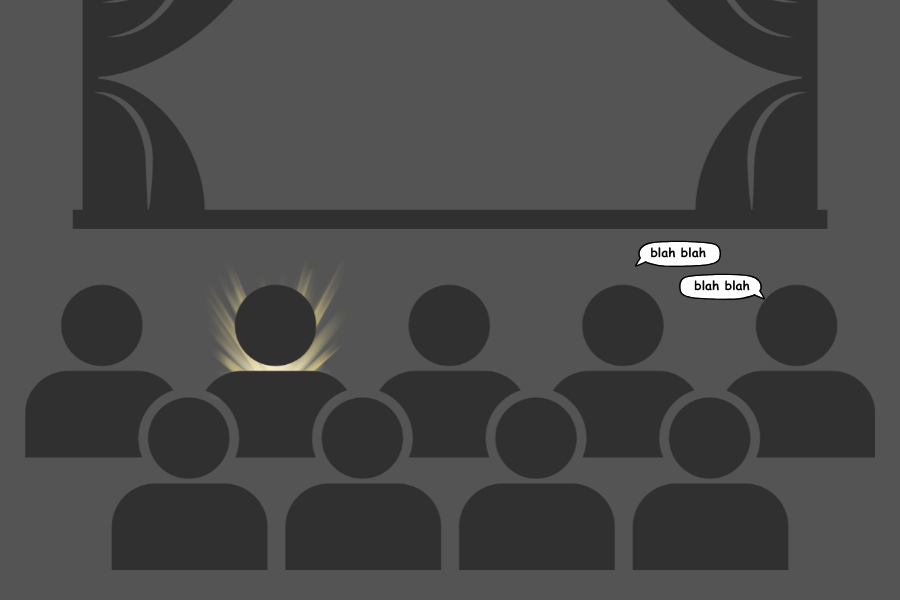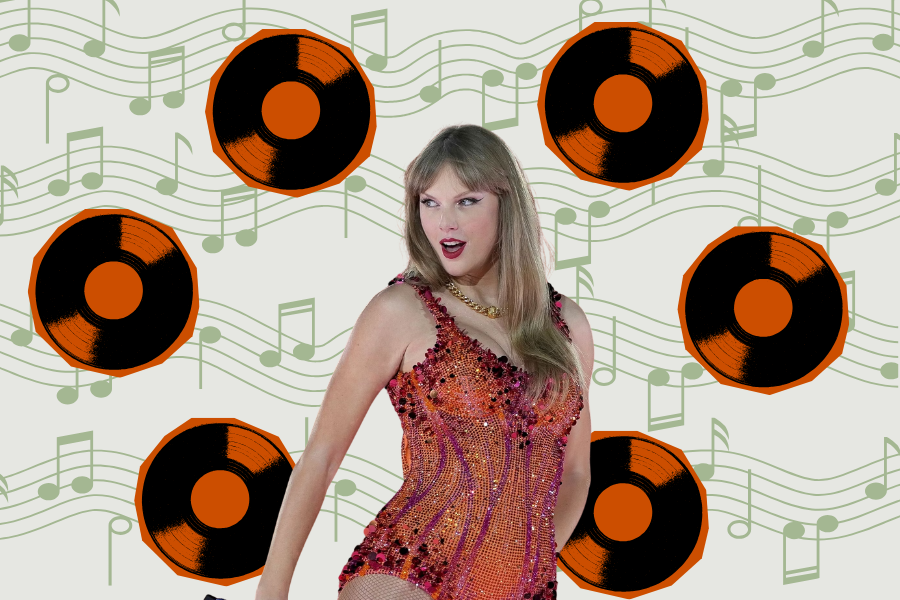In the 1952 American Quarterly article “Movies and Audiences,” David Riesman and Evelyn T. Riesman wrote that “association of movies with the concept of escape may be a way of playing down the revolutionary or insubordinate role of the media, for one’s children, or the lower strata, or even the childlike or less responsible parts of oneself.”
Despite the publishing date, there isn’t a more appropriate time to reflect on this than now.
Before addressing the issue strangling modern theater etiquette, there are several vignettes that might prove horrifying for a film enthusiast and suffice as examples of poor conduct.
A phone rings several times and a man proceeds to engage in a loud conversation during Andrew Scott’s and Claire Foy’s pivotal final meeting in “All of Us Strangers.”
A woman at a packed showing of “Dune: Part Two” searches on a phone at the highest brightness “dune two runtime.”
Two ladies talk louder as each minute passes during a matinee of “Materialists” as though no one else in the theater exists.
A man directly in front of me scrolls through Wikipedia articles as Zac Efron speaks the final heartbreaking words in “The Iron Claw.”
A drunken audience member hollers at Mikey Madison during a late night screening of “Anora” before passing out and falling out of his seat.
A large portion of the population has lost respect for the moviegoing experience. There are several major catalysts for this. The availability of mass streaming pries at the pockets of every family in America. The presence of the cellphone is now unavoidable, impossible to detach from its owner. Lastly, the internet, which has turned every little thing into online discourse all while refusing to think critically about art which has become mindless consumption and shallow conversation; alienating people from truly interacting with the medium of film.
It is rare these days that a moviegoing experience is uninterrupted. The “escape” the Riesmans mention is no longer the core of the problem when people have become so cavalier about the art they consume. They refuse to maintain the space – a theater — to sit down and experience it. There can no longer be an escape when phone screens light up a row of seats, or when audience members talk endlessly throughout a showing like it’s their living room. A theater is a space built for a reason. The audience is a collective, bonded through a shared piece of art. This cannot happen when so much threatens to break this bond.
In Ian Scott’s piece for The Salt Lake Tribune “Movie theater etiquette is dead, and I’m tired of it,” his discontent with distracting behavior in a theater can be filed down to one statement, that “now your movie experience is in the hands of the strangers around you,” who may not have the same reverence for film that you do, or at least the decency to act in a considerate manner in a shared space.
During the height of COVID-19 closures, demand for streaming services like Netflix and HBO shot up. Since then, theaters have opened and behavior has changed drastically. This isn’t to say poor etiquette is entirely a symptom of a post-COVID world —- Richard Butsch’s article “American Movie Audiences of the 1930s” mentions some unruly conduct during and after the decade in question, but the lack of cellphones during the 1930s limited audience reaction exclusively to human disruption.
In 2025, this is not the case.
Dan Hassoun’s article “Engaging Distractions: Regulating Second-Screen Use in the Theater” notes that “AMC Theaters has been one of the most aggressive” in “creating ‘emotionally invested’ experiences tied to the theater” by introducing “more comfortable recliner chairs…and programs meant to boost the ‘friendliness and helpfulness’ of the staff.” This focus on “creating” experiences, however, has not stopped patrons from scrolling or interrupting a film.
Out of any movie house in Boston, my run-ins with rude theater-goers have been the most concentrated in chains like AMC, which primarily show box-office hits and studio films with wide theatrical releases that capture a larger audience.
A movie’s audience can be incredibly unpredictable. Dramatic films like “Oppenheimer” could have brought in exclusively Nolan-heads, World War II dads and grandparents who always seem to flock towards a new biopic — mine dragged me to see “The Darkest Hour” one Christmas in eighth grade for some reason. Instead, it reeled in crowds who might not have bought tickets had there not been an internet phenomenon to garner excitement during the months prior to the film’s release.
This large, unexpected audience can be a good thing. People are gathering to see a film that might not have appealed to them or found them through their algorithms otherwise. Nevertheless, this can attract those who rarely see films in-person and tend to act as though they are the only people in the auditorium.
A sardonic individualism has taken hold of so many over the years. How do we ask them to take something seriously when every aspect of their behavior rejects it? Would it be socially acceptable to yell from across the room at a painting in a museum, or take a call during a play? These different venues often ask attendees for the same silence and respect. Why is it so different from one medium to the next?
In “Why Movies Move Us,” Roger Bacon wrote that films “produc[e] the sensation of life, not art,’” as they place the viewer in the shoes — or in his words, the glasses — of an unseen narrator; the one out of frame. This could be the reason for this disrespect — if people are seeing something that appears to be real life onscreen, they rebuke it as an escape and treat the movie house as their own.
There are two solutions that audiences can turn to for a genuine movie-qagoing experience during an era in desperate need of one.
Attending independent theaters is the clear choice for a distraction-free zone. These environments are often fostered by movie lovers, run by volunteers and artists alike who cater to an audience that cares about film. I’ve seen intense conversation, tears and laughter and uninhibited zeal for art at independent theaters that has to stamp out the nonchalance and indifference found elsewhere.
Institutions like The Coolidge, The Brattle, The Somerville Theater and Kendall Square Cinema all show select new releases as well as their other scheduled programs, which include independent film, repertory series, foreign-language film, film festivals and cult classics.
The other option is a lifestyle choice. Outside of simply treating movies with the respect they deserve and removing phones from the equation, whispering instead of loudly chattering throughout a film and showing up on time, there remains a nostalgic component.
When I was a kid, movies were a luxury, even the DVDs or VHSs we owned. There is a magical feeling, all perfumed with the golden haze of childhood, of walking up and down the aisles of the Blockbuster four minutes from my house on a Friday night that can’t be replicated by scrolling through Netflix. Picking a snack, coming to a consensus with multiple friends or family members over which movie to watch and turning out the lights is all a part of setting a tone.
Even going to the mall for a $2 movie as a kid was a treat, sneaking a bag of M&Ms or a lollypop from a candy store in your mom’s purse to avoid the cost of snacks at the theater. These things create memories solid as a rock.
Checking your phone during a movie slowly drains you of this. You aren’t going to remember a fun night on the town seeing “Challengers” if scrolling on Instagram — an activity that can take place anywhere, anytime — is obscuring your focus. Tuning in and out of a film will not only rob you of something to look back on, and the $15.50 you spent to distract others by turning your brightness up, but it will also dilute your ability to understand the importance of what you are seeing.
It doesn’t matter how bad the film is. You might even take more away from a screening of a movie like “Four Rooms” (1995) without a phone than scrolling throughout the entirety of a masterpiece like “Persona” (1966).
Make a day out of something. Treating films solely as either a subject of discourse or the way to end a long day as you wind down, diluting any possible original thought creeping into your mind is not a sustainable way to treat art, or yourself.
Streaming has made movies so available, so take advantage of this. Turn off your lights and remember something. Treat it as an event that you can curate. Make popcorn, pick up some ice cream from your corner store or invite friends over to prevent participating in online discourse and encourage genuine human interaction instead.
Become someone who chooses to treat things with the earnestness and respect they deserve. Apathy is not an enviable state, and we must stop treating it as such.









